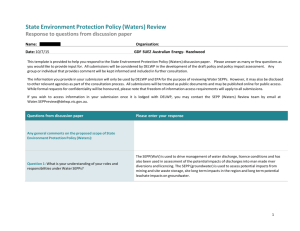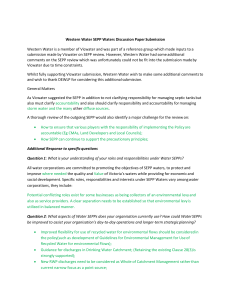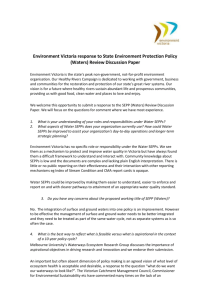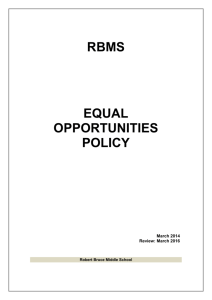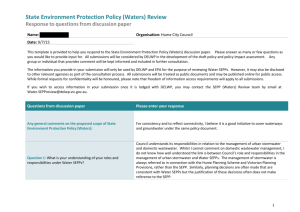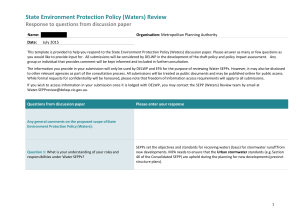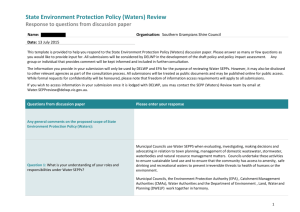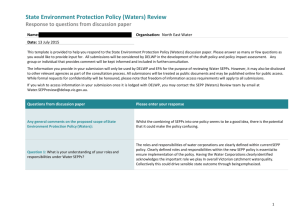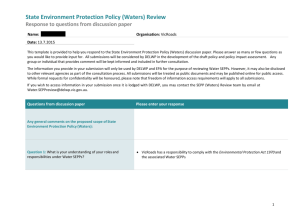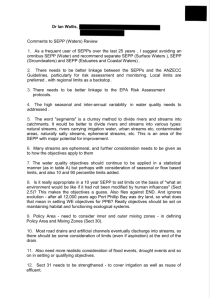River Basin Management Society (Accessible version) [MS Word
advertisement
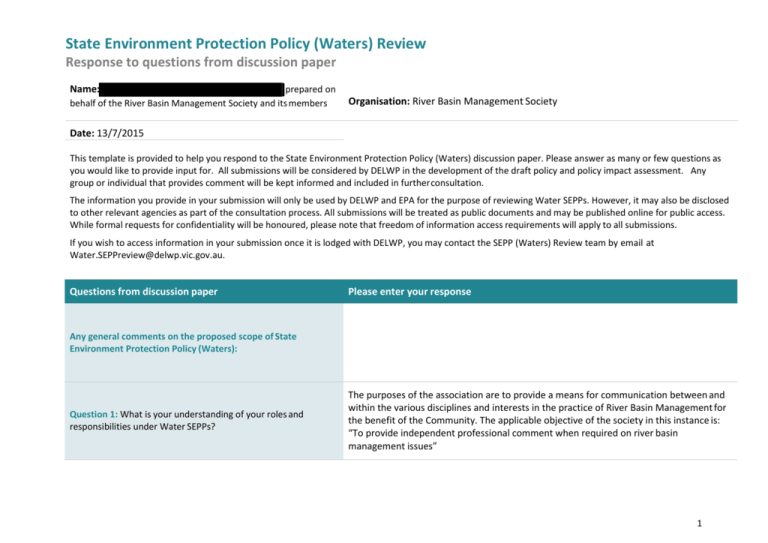
State Environment Protection Policy (Waters) Review Response to questions from discussion paper Name: prepared on behalf of the River Basin Management Society and its members Organisation: River Basin Management Society Date: 13/7/2015 This template is provided to help you respond to the State Environment Protection Policy (Waters) discussion paper. Please answer as many or few questions as you would like to provide input for. All submissions will be considered by DELWP in the development of the draft policy and policy impact assessment. Any group or individual that provides comment will be kept informed and included in further consultation. The information you provide in your submission will only be used by DELWP and EPA for the purpose of reviewing Water SEPPs. However, it may also be disclosed to other relevant agencies as part of the consultation process. All submissions will be treated as public documents and may be published online for public access. While formal requests for confidentiality will be honoured, please note that freedom of information access requirements will apply to all submissions. If you wish to access information in your submission once it is lodged with DELWP, you may contact the SEPP (Waters) Review team by email at Water.SEPPreview@delwp.vic.gov.au. Questions from discussion paper Please enter your response Any general comments on the proposed scope of State Environment Protection Policy (Waters): Question 1: What is your understanding of your roles and responsibilities under Water SEPPs? The purposes of the association are to provide a means for communication between and within the various disciplines and interests in the practice of River Basin Management for the benefit of the Community. The applicable objective of the society in this instance is: “To provide independent professional comment when required on river basin management issues” 1 State Environment Protection Policy (Waters) Review Response to questions from discussion paper Question 2: What aspects of Water SEPPs does your organisation currently use? How could Water SEPPs be improved to assist your organisation’s day-to-day operations and longer-term strategic planning? N/A. See response to “Any other information you would like to share”. Question 3: Do you have any concerns about the proposed working title of State Environment Protection Policy (Waters)? If so, what are they? The RBMS is comfortable with the working title, but only if there is no net loss in environmental outcomes as a result of combining the Groundwater and Surface Water SEPPs. Question 4: What is the best way to reflect what is feasible versus what is aspirational in the context of a 10-year policy cycle? Our understanding of an environmental objective should be developed enough to determine whether an appreciable difference can be made to meet the objective in a ten year timeframe. If science, planning, policy, financial constraints cannot be overcome in a ten year timeframe then the objective is aspirational and shorter term goals should be developed to progressively work towards the objective. If an appreciable difference can be made within a ten year time frame then the objective is feasible. Question 5: Do you support the proposed SEPP (Waters) objective of “this policy is to protect and improve the quality of Victoria’s waters while providing for economic and social development”? Why? Question 6: Do you support the need to balance economic and social development with overall protection and improvement of water quality for Victoria’s water environments? Why? Why do we need to provide for economic and social development with this Policy? Economic and Social development is supported through other initiatives and have been progressing despite existing shortcomings in SEPP WOV Objectives. The RBMS believes the addition of economic and social development objectives detracts from the purpose of this policy. As above. 2 State Environment Protection Policy (Waters) Review Response to questions from discussion paper Question 7: What are the challenges of balancing economic and social development with protecting and improving water quality? How should we manage the appropriate trade-offs between them? Improved WQ doesn’t have an economic return in the short term which makes it a challenging objective to aim for. The question of trade-offs implies that there has to be a trade-off. Instead we should be investing time into progressing solutions that have shown to produce win-win-win outcomes. One combined SEPP is perfectly reasonable and is supported by the RBMS but only if appropriate exceptions are defined to capture the physiological differences between ground and surface water. Question 8: Do you foresee any problems or opportunities that may arise from creating one consistent SEPP to apply to all Victorian waters? Are there other options for streamlining the policies that we should consider? Much of the introduction and justification for the SEPP can be consistent for ground and surface water however it would be detrimental if the value of two separate policies was lost. If done well this is an opportunity to acknowledge to interconnectivity of both systems whilst catering for the different environmental threats, parameters, intervention techniques, timescales and beneficial uses. A risk is losing out on the best of both policies whilst the opportunity is to benefit both i.e. coequal goals. Question 9: Are there any specific types of water environments, for example, a wastewater treatment lagoon, where you think beneficial uses should not be protected? No. Effort should really go into defining beneficial uses for all waterbodies. Question 10: Do you think the current measures for classifying surface water and groundwater segments are still appropriate? Are there other measures that should be explored? The current segments are overly complex and were developed over time i.e. more and more schedules to cater for our understanding of the complex differences between aquatic ecosystems. The RBMS believes it’s the appropriate time to be resetting how segments are defined. 3 State Environment Protection Policy (Waters) Review Response to questions from discussion paper Question 11: Are there any problems with the spatial arrangements or segment boundaries in the existing Water SEPPs? If so, what are they? No problems have been identified with existing spatial arrangements or segment boundaries. As per Q. 10 the identified issues are that many of the schedules are inconsistent and have all been developed at different points in time. The RBMS is broadly supportive of the new segments but believes that further work should be undertaken to break down the Groundwater Segments into more meaningful segments. Question 12: What do you think are the advantages or problems with the new approach to segments and sub-segments? For instance, consideration of the National Aquifer Framework and the National Groundwater Information System could be used to define segment boundaries. Currently only TDS is used to categorise GW and the RBMS believes that this doesn’t reflect the aquifer typology and structure. Question 13: Are there any features of the landscape that you would like to see as a standalone segment or sub-segment? As per the above the RBMS believes further work could be undertaken to define Groundwater segments. For instance areas such GW discharge/recharge zones. i.e. beneficial use is the symbiotic relationship b/w groundwater and surface. An example could be the peat bogs/sphagnum bogs at top of 7 creeks catchment/Strathbogies. Question 14: Do you believe that all beneficial uses set out in Table 2 of the discussion paper should still be protected under the new SEPP (Waters)? Where do you think a beneficial use would not apply? Why? Yes. As per the response to Q9 effort should be spent defining beneficial uses for all waterbodies. Question 15: What method or approach could be used to apply the beneficial uses to segments and sub-segments? Beneficial uses should be set by the best available science and with input from the community. i.e. Community perception should drive whether a river should be swimmable or not. Whether people currently swim there should not be used to determine whether the waterway should be swimmable in the future. Beneficial uses should not be determined or influenced by whether or not the objectives required to maintain or achieve these uses are aspirational or beneficial. 4 State Environment Protection Policy (Waters) Review Response to questions from discussion paper Question 16: Are there any additional beneficial uses that you believe should be protected? Are there any that you think should no longer be protected? Why? RBMS suggests that Groundwater Ecosystems could exist as a standalone beneficial use. Or inclusion of Groundwater in the existing Aquatic Ecosystems. Question 17: What do you think about the current indicators, the approach for deriving objectives and the proposed changes? The suite of indicators is deemed acceptable however as per feedback in earlier questions, the RBMS strongly believes further work is required to determine indicators in groundwater. It is not clear how the balance between competing beneficial uses in ‘sustainable working rivers’ will be determined. This represents the greatest risk when deriving objectives because it is possible that few/no aspirational targets will be set in areas such as ports/irrigation areas where multiple uses exist. Question 18: How have nutrient load targets been useful in driving environmental investment outcomes? Would you like to see a different approach, and if so, what might that be? Can load caps be retained with inbuilt concentration limits for point sources? Nutrient load targets seem particularly in managing or setting targets for multiple diffuse sources where regulation or enforcement is impractical. Question 19: What is the preferred method for management of at-risk areas? Are there activities that need greater intervention or regulation? What would the intervention be, for example, voluntary or mandatory codes of practice, regulation via licensing? A range of statutory mechanisms should certainly be explored and the trend should be for clear, simple and enforceable actions. Current levels of regulation and enforcement on known pollutant sources are not adequate so the emphasis in the development of management actions should be ensuring that management actions are enforceable and that adequate resources are provided to carry out enforcement. Question 20: What do you think the role of SEPP (Waters) should be in identifying and filling knowledge gaps over the life of the policy? How can we assure an adaptive approach within SEPP (Waters)? The RBMS believes the requirement for an adaptive approach and the mechanisms to enable knowledge gaps to be progressively filled should sit inside the SEPP however whether the SEPP’s role is to identify or fill knowledge gaps or whether this sits outside of the policy is not deemed critical. If a funding stream to undertake this process is more attainable if the function sits within the SEPP then this is where it should reside. 5 State Environment Protection Policy (Waters) Review Response to questions from discussion paper The River Basin Management Society is a member based organisation comprising policy professionals, scientists, engineers, economists and practitioners from academia, not for profit organisations, government and private enterprise working in the field of catchment and waterway management. The RBMS has approximately 230 members with an average work experience of 10 years, creating a knowledge base of over 2,000 years. The objectives of the RBMS include: Any other information you would like to share: To provide a forum in Australia for interchange of multidisciplinary knowledge and skills in the field of river basin management. To recognise, declare, promote and disseminate advances in river basin management. To encourage the interchange of those engaged in river basin management within Australia and overseas. To provide independent professional comment when required on river basin management issues. The scope, effectiveness and efficiency of legislation, policy and strategies governing the management of Victoria’s waterways and catchments are of particular interest to the RBMS. We welcome the opportunity to comment on the SEPP WOV Review. The RBMS canvassed its members for any comments and also ran a special reading group session to discuss the Review. This submission is based on that feedback. 6
